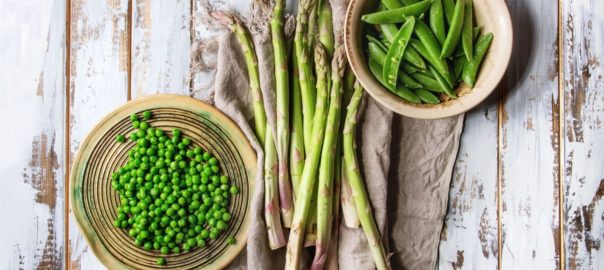Spring is here and brings with it new foods that are at their peak of freshness. How many of these in-season foods can you add to your diet every day?
Click on the links to find recipes boasting affordable, nutrient-rich, and better-tasting seasonal produce.
Artichokes
Native to the western and central Mediterranean, artichokes are low in fat, rich in fiber, vitamins, and minerals like vitamin C, vitamin K, folate, phosphorus, and magnesium.
Moreover, artichokes are among the richest sources of antioxidants. These delicious thistles are usually served as a hot vegetable with a sauce or as a cold appetizer.
Asparagus
Asparagus is native from Siberia to southern Africa. It is high especially high in vitamin K and folate, essential nutrients that help lower blood pressure and support healthy pregnancy.
Asparagus is low in calories, high in fiber, and contains 94% water, making it ideal for your digestive health. You can easily incorporate it into your diet; you can add it to salads, omelets, and it also makes a great side dish!
Broccoli
Broccoli, also abundant in January and February, is a superfood native to Europe. Low in calories and packed with many micronutrients, minerals, fiber, and antioxidants, broccoli has a reputation for helping to boost immunity and promote heart health.
The Institute for Functional Medicine suggests eating 2-3 cups of broccoli per day. Broccoli can be eaten cooked or raw. When cooking, it can be sautéed, steamed, roasted or air fried. If you plan to serve it without cooking, it's great for salads or dips.
Cauliflower
Not many vegetables contain choline. Cauliflower, along with broccoli, is among the sources of this nutrient that most people are lacking. Although the body makes some choline, we still need to consume choline-rich food to get enough.
Consuming a sufficient amount of choline may reduce the risk of several health conditions, including cardiovascular disease, cancer, and dementia.
If you're following a low-carb diet, cauliflower is a healthier choice to replace grains and legumes in a wide variety of recipes. I often like to curry cauliflower for a change of taste. The flavors of curry go well with cauliflower and greens. You can also try my autumnal cauli-mash recipe with roasted, crunchy Brussel sprouts.
Leeks
Leeks are an ancient crop and are native to eastern Mediterranean lands and the Middle East. Its close relatives are onions, shallots, scallions, chives, and garlic.
Low in calories but high in nutrients, such as magnesium and vitamins A, C, and K, leeks also contain some fiber, copper, vitaminB6, iron, and folate.
They're widely used in soups and stews. You can also enjoy leeks in dips, salads, and quiche.
Lettuce 
Lettuce is a nutritious vegetable in the aster family. Although it comes in many varieties, this leafy veggie, in general, is rich in vitamins K and A. Note that red leaf lettuce is higher in antioxidants.
Most lettuce varieties, such as iceberg and romaine, are eaten fresh and often served in salads, wraps, and sandwiches.
Mushrooms
Mushroom is a type of fungi, but the term “mushroom” is used to identify edible sporophores. It is considered a vegetable for cooking purposes.
Mushrooms also come in a lot of different shapes, sizes, and colors. The most common types found in the grocery are shiitake, portobello, button, oysters, and crimini.
They are a rich source of antioxidants, potassium, beta-glucan, and B vitamins for heart health and copper for bones and nerves.
My favorite way to eat mushrooms is by tossing them into eggs, soup or using them to create my no-bean chili recipe.
Pineapples
ineapples are delicious tropical fruits native to the Caribbean islands and Central and South America.
They are low in calories and loaded with antioxidants and compounds that can reduce the risk of chronic diseases, improve digestion, lower the risk of cancer, boost immunity, ease arthritis symptoms, and speed up recovery after surgery or vigorous exercise.
Serving one cup of fresh pineapples along with your usual breakfast or blending frozen pineapples into smoothies is a refreshing way to start your day!
Radish
Radish varieties are an excellent source of fiber, vitamin C, and antioxidants. Compared to other root vegetables, they have fewer carbs and calories.
Strong immune system, better digestion, and increased bile production are just a few of the many radishes' health benefits. Note that radishes are generally safe to eat, but people with thyroid problems must consume them in moderation.
Using Daikon radish root to substitute for ramen noodles is my personal favorite!
Rhubarb
Rhubarb is classified as a fruit by the USDA. It is a good source of antioxidants, vitamin K, and fiber. Note that rhubarb may be high in oxalate and best to avoid if you are prone to kidney stones.
Due to its sour and slightly sweet taste, its fleshy, tart leafstalks are usually sugared for use in pies, jams, and crumbles.
Spring Peas
Green peas are actually not a vegetable. They are part of the legume family, consisting of plants that produce pods with seeds inside. Other examples of legumes are lentils, chickpeas, and beans.
What makes peas unique is their high protein content. Half a cup of peas contains 4 grams of protein.
Note that raw peas contain higher antinutrients that may disrupt the absorption of some nutrients. So it’s best to eat them fully cooked, fermented, or soaked.
 When eating fresh, in-season produce, don’t forget to wash it first. Click here to get your toxin-free fruit and veggie wash!
When eating fresh, in-season produce, don’t forget to wash it first. Click here to get your toxin-free fruit and veggie wash!
[expand title="Sources"]
https://www.britannica.com/plant/pea
https://www.britannica.com/search?query=asparagus
https://www.healthline.com/nutrition/rhubarb
https://www.healthline.com/nutrition/asparagus-benefits#TOC_TITLE_HDR_8
https://www.britannica.com/plant/Asteraceae
https://www.ncbi.nlm.nih.gov/pmc/articles/PMC6259877/
https://www.ncbi.nlm.nih.gov/pmc/articles/PMC2841576/
https://www.britannica.com/plant/rutabaga
https://www.healthline.com/nutrition/rutabagas
https://www.britannica.com/plant/turnip
https://www.healthline.com/nutrition/turnip-nutrition
https://www.medicalnewstoday.com/articles/284815
https://www.medicalnewstoday.com/articles/270435
https://www.britannica.com/plant/leek
https://www.healthline.com/nutrition/leek-benefits
https://www.britannica.com/plant/cauliflower
https://www.healthline.com/nutrition/benefits-of-pineapple
https://www.healthline.com/nutrition/benefits-of-cauliflower
https://www.britannica.com/plant/broccoli
https://www.healthline.com/nutrition/foods/broccoli
https://www.medicalnewstoday.com/articles/266765
https://www.britannica.com/plant/Brussels-sprouts
https://www.healthline.com/nutrition/benefits-of-brussels-sprouts
https://www.medicalnewstoday.com/articles/284765
https://www.britannica.com/plant/Brassica-olerace
[/expand]





